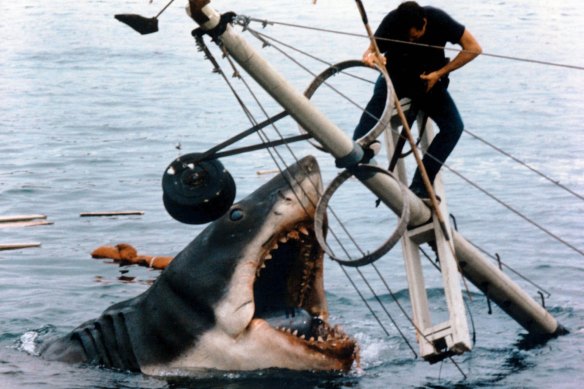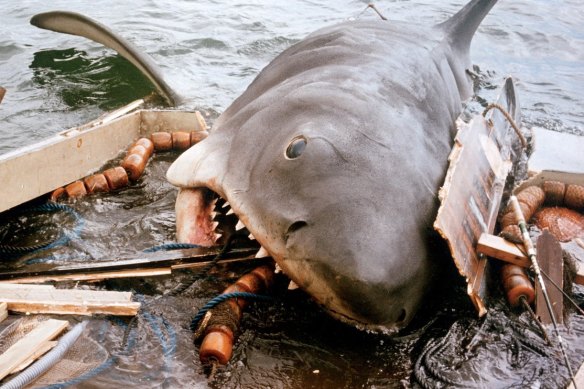By Nell Geraets
Ever since a jagged dorsal fin broke the water’s surface in Steven Spielberg’s Jaws half a century ago, shark movies have been reeling in audiences.
Like Christmas films, new iterations continue to be churned out, ranging from the traditional horror of Open Water and The Reef to the tongue-in-cheek farce of Sharknado and Toxic Shark. More recently, star-studded blockbusters like The Meg have taken a bite out of the box office, inspiring a second go-around in the upcoming Meg 2: The Trench.

Jaws set off the shark movie craze that inspired horror classics like Deep Blue Sea and tongue-in-cheek whirlwinds like Sharknado.Credit: Universal / The Kobal Collection
But you can’t just throw a great white in any body of water and assume it will be a crowd-pleaser. There’s an art to the schlock. So, what is it about shark movies, out of all the big scary animal tropes, that keeps bringing us back?
Entertaining – dare we say, killer – shark movies contain some variation of the same foundational ingredients that are bound to pull in audiences hook, line and sinker.
A shark kept largely off-screen
The man-eater in Jaws, which is about a coastal town facing the threat of being shut down when a killer shark is discovered in the waters, is a combination of real-life great white footage and five animatronic sharks (all of which the cast named “Bruce”). Though CGI is nowhere to be seen in the film, the sharp-toothed villain remains one of the most spine-chillingly believable of all fictional sharks.

“Bruce”, the mechanical shark in Jaws, was spine-chillingly convincing for the 1970s.Credit: Universal Pictures
If you are showing the shark, best to use the real thing! Open Water (2003), which is based on the true story of two scuba divers stranded by their tour boat in shark-infested waters, uses various sequences of real sharks. In fact, National Geographic reported a shark expert introduced the movie’s crew to grey reef sharks and bull sharks. Its directors would also throw chum into the water while filming to capture genuine scenes of thrashing sharks. In 2010, Andrew Traucki’s The Reef – in which a shark hunts swimmers after their yacht sinks – used underwater footage of the creatures.
Regardless of how a director chooses to depict their black-eyed beast, the trick is to keep the mystery alive. The Jaws shark is famously visible for only about four minutes of the film. It also doesn’t appear until over an hour has elapsed. The audience is kept on the edge of its seat (helped in large part by the renowned score) imagining what could be beneath the water’s surface rather than being hit over the head with hours’ worth of cartoonish CGI sharks.
A greater purpose
No one expects a shark film to be the next Citizen Kane, but those that kill at the box office tend to have a bit more substance.
For example, Jaws resonated partly because it tapped into public distrust in government. It was released in the year after Richard Nixon resigned as US president over the Watergate scandal. In the film, the mayor conceals the fact that there’s a killer shark, for fear of affecting the town’s tourism.
Meanwhile, Deep Blue Sea has a meaningful – albeit ludicrous – moral, something mediocre shark movies must have if they are to maintain an audience after the first adrenaline-pumping kill.
It features a group of scientists who become prey to hyper-intelligent sharks while working on a cure for Alzheimer’s disease in an isolated research facility. Though slightly on the nose, it notes the dangers of genetic enhancement and animal testing. This adds nuance to a film that would otherwise present sharks as merely mean, lean killing machines, which is one-note and outdated given research suggests sharks are not usually intent on hunting humans.
If the film doesn’t teach you something, then perhaps it will pull on your heartstrings. The Reef: Stalked (2022), which follows four young women as they’re terrorised by a shark while kayaking in the ocean, is essentially an allegory of domestic violence and PTSD. Two of the women were traumatised after witnessing their sister being killed by her partner. As they battle against the “man in the grey suit” (the shark), they simultaneously battle their grief and trauma.

The Reef: Stalked explores the impact of domestic violence and PTSD.Credit: Thrills & Spills
High Stakes (aka mortal peril)
Nothing is worse than a shark film where nobody dies or no one’s livelihood is destroyed.
A good shark film must put something valuable on the line. Jaws doesn’t just confront viewers with a hungry shark, it presents viewers with a hungry shark that could ruin summer. That means big bucks flowing down the drain and the reputation of the Amityville beach town permanently tarnished.
But let’s face it – many audience members will be there for the gore. Some of the most entertaining shark movies have the highest kill counts: 11 people are killed in 2018’s Santa Jaws (about a drawing of a Christmas-themed shark that comes to life), about 15 people die in Deep Blue Sea 3 and about 27 people die in The Meg.
Granted, many of these deaths are people with little relevance to the film, but it still portrays just how deadly these apex predators can be.
But these movies don’t have to be bloody to be bloody good. In The Shallows (2016), where a young surfer (Blake Lively) must fight off a determined shark after she becomes stranded on a reef, there’s no giant kill count. Instead, the stakes lie in how frustratingly close to shore she is for the entire film. Just 180 metres from safety, yet she struggles to break free, leaving the audience feeling just as helpless.
If it’s going to be schlocky, it must lean all the way in
Though some have a degree of emotional depth, few contemporary shark films take themselves too seriously. But for this to be enjoyable, it cannot languish somewhere between serious and silly.
A film that never shies away from full-throttle schlock is Sharknado (2013). Sharks raining down from the sky? You can’t mistake that for an arthouse feature made for Cannes. That film was so popular with audiences, they made five more (with one officially called Sharknado 3: Oh Hell No), as well as two spin-offs, two documentaries, a mockumentary and a video game.
Others include Sharktopus (2010), which is about a half-shark, half-octopus. 2-Headed Shark Attack (2012) is about a mutated double-headed monstrosity, which is then followed by 3-Headed Shark Attack, 5-Headed Shark Attack and, you guessed it, 6-Headed Shark Attack. Toxic Shark (2017) sees an acid-spewing shark terrorise visitors on an island retreat, acid-burning some to death while turning others into zombie-like beings.
The Meg, which is about a prehistoric giant shark that escapes from the depths of the Mariana Trench, makes its ridiculousness apparent from the get-go thanks to its tagline, “new Meg, old chum”. The second instalment will be just as deliciously cheesy, as the audience is promised encounters with multiple giant Megalodons.
These films may not be symbolically profound, but they are original, memorable takes on the killer shark genre that are sure to have theatres and living rooms filled to the gills.
Meg 2: The Trench is in cinemas from August 3.
Find out the next TV, streaming series and movies to add to your must-sees. Get The Watchlist delivered every Thursday.